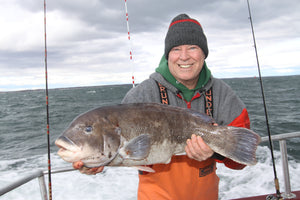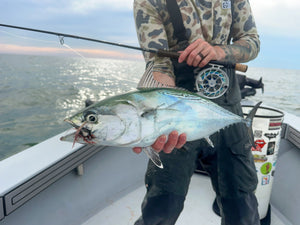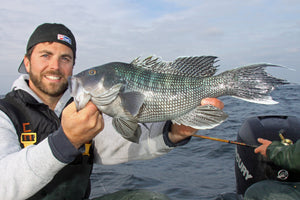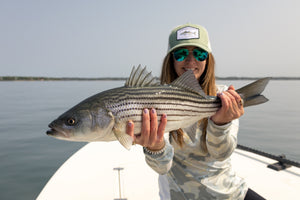Three Basic Outfits for Novice & Intermediate Inshore Anglers

One highlight of spring on Long Island’s East End is the great inshore fishing to be found in the bays and Long Island Sound during May, June and early July. Any day this time of year can find anglers tangling with multiple species ranging from porgies, weakfish, fluke and sea bass to blues and stripers of all sizes. Toss in a few extra bycatches like blowfish, kingfish and, of course, sea robins, and it’s possible to ice move than a half-dozen edible species on any given day.
In an ideal world, we’d all be able to carry specific fishing rod and reel combos, rigs and lures to cover each aspect of this entire array. For novice and intermediate anglers, however, having two or three combos to enjoy as many possibilities as possible probably makes more sense. To that end, here’s three great setups that should usher you through the season ahead with plenty of success. If you are just building your arsenal now, or upgrading your current gear, we suggest starting by adding the basic setup that matches the species you like to pursue the most. At that point, you can add additional setups, upgrade or even check if a custom rod built here at the shop will take you to an even higher level.
 Light spinning outfits are great fun for spring-time weakfish and fluke fishing in the bay.
Light spinning outfits are great fun for spring-time weakfish and fluke fishing in the bay.
Basic Inshore Bottom Fishing
If you enjoy basic bottom fishing in the bay and Long Island Sound, a truly great setup would match a 6’3” medium-weight Centaur Slow Jigging Spinning Rod with either a Daiwa BG MQ 4000 or Shimano Stradic FM 5000 spinning reel. Spool up this with 15-pound test Daiwa J-Braid 8 Strand line, add a five-foot length of 12- to 20-pound Seaguar Blue Label Fluorocarbon leader material, and you are set to go.
This outfit is ideal for working soft to moderate currents in water depths up to 40 or even 50 feet using sinkers weights from two to six ounces or one- to three-ounce jigs. It’s perfect for pounding on humpbacked porgies, keeper fluke and summer run weakfish from spring right through the fall.
This Centaur Slow Jig Rod is quite sensitive yet boasts enough backbone to provide the upper hand should you set the hook on a true doormat, tiderunner weakfish, double-digit chopper or striper of keeper proportions.
The saltwater resistant Daiwa BGMQ spinning reel features good cranking power, a strong yet smooth drag, and stands up great to the abuse and pounding dished out by a saltwater environment. With its strong but lightweight Monocoque design, the reel body serves as a stiff and distortion-proof frame that is handy and compact at the same time. It offers more rigidity, more stability, and bigger gears than most other reels in its class, and its maximum drag setting is an impressive 22 pounds.
The Shimano Stradic FM spinning reel boasts InfinityXross technology for unequaled gear durability and synergy by extending the gear tooth horizontally to distribute load across the gear tooth more evenly. This parlays Shimano's legacy of cold-forged HAGANE gearing for added strength with the refinement of MicroModule II for the ultimate reeling experience. At the same time, a Duracross Drag system provides super-smooth performance with up to ten times the durability of competitive drag systems.
Of course, which reel you’ll choose to complete this setup is a matter of personal preference – but you can’t go wrong with either one. Stop by the shop and try them out to see which feels better in your hands when it’s matched to that Centaur rod.
Digging Deeper
If you fish a lot in deeper water with heavier weights, you are going to need more power. For this application, consider something along the lines of a 7’6” Jigging World Hybrid Nano Carbon Casting Rod matched with a 30-class reel Daiwa Saltist Star Drag conventional, or a Shimano Torium 16. This is your heavy stick, able to work with weights from 4- to 10 ounces, jigs from 2 to 6 ounces, and tins in the 3- to 6-ounce class. Fill the reel with 30- to 40-pound-test Power Pro Braided Line and you are off to the races.
This is an ideal setup not only for bottom-fishing, but for live lining stripers as well. Quite simply, it can manage anything you might hook in the bays, Sound or nearshore ocean waters while still allowing you to enjoy a spirited battle at the end of the line. With nano carbon technology, the Jigging World rod is a lightweight marvel with extraordinary power. The Daiwa Saltist is renowned for its powerful drag and a true freespool that allows for longer casts and uninhibited spool pay out that is ideally suited for fishing with live bait. The lightweight Shimano Torium 16, meanwhile, comes packed with features like a Super Stopper, Cross Carbon Drag, A-RB (Anti-Rust Bearings) and High Efficiency Gearing in both right and left-handed models (designated by and L at the end if it’s model number). This really is a sweet and versatile setup for the cost.
Cast Away
With the bottom game well covered, a solid spinning outfit will give you more range and flexibility when it comes to presenting jigs, poppers and other lures, as well as live baits. For this application, we suggest starting with something along the lines of a medium-fast action 6-foot, 6-inch or seven foot St. Croix Premier or Mojo Inshore spinning rod matched to a 3000 class Daiwa Saltist MQ, BG MQ spinning reel, or Shimano Spheros SW 4000.
With this combo, you’ll be able to pop and walk the dog with surface lures for bass and blues, jig for fluke and sea bass both inside the bay and on nearby ocean reefs or around Long Island Sound wrecks and boulder fields, and live-line big live baits for stripers, blues and weakfish that are tracking bunker pods. Hook up on a school of big fish feeding on the surface and you’ll quickly realize you made a great choice putting this package together.
Of course, there’s always another setup to add to your fishing arsenal – and its great to have rods built for specific species or applications like snap jigging, working large plugs and spook lures, or hauling big triggerfish and bulldog blackfish out their nasty lairs. The better and more experienced you get, though, the more you’ll be able to appreciate the finer differences between setups. At which point you’ll realize it might be time to step up to the next level.
For now, though, if you consider yourself a novice or intermediate level angler, the ability to address a variety of situations with a limited number of fishing outfits can be a big plus. Start with these basic outfits, get to know what it is you like most about tempting your favorite species, and refine your choices over time from there.
And remember, we are always here to answer your questions, offer advice and help you fine-tune any rod and reel combo.
- Bryce Poyer






